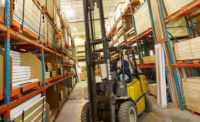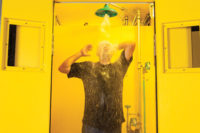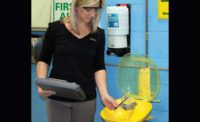Freezing temperatures and outdoor work environments are not a good mix. Not only are frigid conditions hard on warm-blooded humans as they perform and execute their jobs, they can also wreak havoc on plumbed safety equipment, such as emergency showers and eyewashes that require on-demand heated water at a second’s notice.
Then there are other worksite extremes — like oppressively high temperatures, chemicals, high winds, explosive/ignitable dust, etc. — that can also jeopardize optimal safety shower performance.
Even the most challenging worksite must have emergency eyewashes and drench showers that are able to deliver ANSI-required tepid water that is conducive to flushing hazardous materials from the eyes, face and/or body for 15 minutes.
Fortunately, whether the issue is an arctic blast, sweltering heat or dust bowl conditions, today’s advanced water heating technologies make emergency drench showers and eyewashes fully operational 365 days per year.
There are a variety of eyewashes, drench showers and water heating technologies that help keep employees safe in extreme, frigid and corrosive environments – even if there is an absence of plumbed water. In particular, these freeze-protected products can be installed outdoors in places ranging from petrochemical facilities, offshore platforms, oil and gas refineries, power generation plants, mines and so on.
ANSI compliance for safety showers in freezing environments
Extreme environments can lead to a number of challenges relative to safety showers. Sub-zero temperatures can cause pipes to break or burst and cause systemic damage affecting the usability of the safety equipment. American National Standards Institute (ANSI/ISEA) Z358.1–2014 Standard Section 4.5.5 states “Where the possibility of freezing conditions exists, the emergency shower shall be protected from freezing or freeze-protected equipment shall be installed.”
No matter the weather, the current ANSI/ISEA standard calls for emergency eyewashes and drench showers to deliver tepid water (60–100° F/15.5–37.7° C) for a full 15 minutes to ensure adequate flushing of hazardous materials from users’ bodies and/or eyes. For drench showers the minimum flow rate is 20 GPM (76 L-MIN); for Eye/Face Wash the minimum flow rate is 3.0 GPM (11.4 L-MIN); and for Eye Wash the minimum flow rate is 0.4 GPM (1.5 L-MIN).
All plumbed emergency safety equipment — no matter the environmental conditions — must have unfailing access to properly heated water to help avoid worker injury, prevent workers from having to use ice cold water (or discovering the pipes are frozen) in the event of an emergency, and avoiding equipment downtime and costly repairs.
The following are adaptable safety shower products that help meet ANSI/ISEA requirements in both freezing and challenging settings.
Heat trace units
Heat trace units guard against frigid temperatures so that water doesn’t freeze in the fixture, putting safety fixtures at risk for frozen pipes and parts.
These specialized showers — available as combination shower and eyewash units – feature insulated jackets over an electrical heat trace cable that wrap the piping with an ABS shell and protects the water from freezing. Should power fail in cold temperatures, these units feature a freeze protection valve that will open when the water temperature drops below 35° F and bleed out water until it warms up again.
Some units are protected from freezing down to -50° F/-46° C. Like enclosed safety showers, these showers can be built for Class 1 Division 1, Class 1 Division 2, and Class 2 Division 2 hazardous locations. An indicator light can be included to show when power is on and when the heat trace cable is heating the unit.
In areas where high winds are prevalent, some units feature entire bowls and bowl covers to protect against wind, debris, and weather. In especially harsh environments, stainless steel eyewash bowls with covers may be used for extra protection from the elements. These models come standard but are configurable as well.
Enclosed safety showers
When harsh environments — extreme weather and highly corrosive conditions – can affect the performance of emergency safety fixtures, enclosed safety showers are necessary for providing a safe refuge. No matter what unique environmental conditions exist, these units can be custom engineered to any particular application with turnkey shower, eyewash and drench hose systems.
These freestanding units are insulated and heated to keep the internal temperature warm down to -40° F (-32° C), making them ideal for sub-zero applications. They also include lighting and a signaling system to provide an audible/visual notification when the safety shower has been activated. The signaling system can also be tied into a remote monitoring facility for faster response.
While some units require a plumbed water supply, there are also self-contained units that will only require a full tank of water and a constant power source. Enclosed safety showers feature the ability to provide tepid water via a tepid water inlet, a hot water tank and a thermostatic mixing valve, a heated self-contained storage tank, or a tankless hot water heater. In accordance with ANSI/ISEA Z358.1 Section 7.4.4, safety systems such as enclosed safety showers with multiple drenching platforms (shower, eyewash and drench hose) must be capable of simultaneous activation while delivering tepid water for 15 minutes.
It is important for these units to be certified to ANSI Z358.1 and consider local electrical (CEC AND NEC) codes along with any explosive atmospheres that may be present. When necessary, these units can be built for Class 1 Division 1 or Class 1 Division 2 hazardous locations.
In all, enclosed safety showers address the physical and psychological needs of the injured party by providing privacy, delivering unlimited tempered water, warm ambient temperature and a shelter from the elements.
Self-contained safety fixtures
When a work environment does not have plumbed water, self-contained, portable gravity fed eyewash units can be an excellent choice. These convenient systems incorporate water tanks that provide adequate water volume to complete a full 15-minute flush of the eyes at the ANSI-mandated flow rate.
When there is a risk of freezing temperatures, gravity fed units can be installed with freeze protection equipment, like a heater jacket. These units can be used with moveable carts to catch and drain fluids.
For specialized situations, gravity fed emergency showers/eyewashes are available. These feature galvanized steel structures and large overhead gravity fed units. In cold environments these models can include an immersion heater to ensure tepid water as well as a heated enclosure to protect the user from freezing temperatures.
Electric tankless water heaters
Tankless water heaters are an excellent option for providing heated water “as needed.” These portable units provide an unlimited amount of water heated at a specific temperature on demand, which makes these water heaters ideal for eyewash and drench shower systems.
Additional benefits of tankless heating units are they draw energy only when needed, reach the ANSI standards for tepid water temperatures in 20 to 30 seconds, hold outlet temperature to within ± 1° F, and have a low pressure drop (as low as 8 pounds per square inch).
Optional features for tankless systems include NEMA 4X stainless steel enclosures, explosion proof purge system, and freeze protection to -20° F (-28° C).
It’s highly recommended to consult with manufacturers and other safety specialists when selecting drench showers and eyewash equipment – especially when dealing with an extreme environment. These experts can identify the best equipment choices and specialized configurations for providing a safe and dependable ANSI-compliant work environment.



